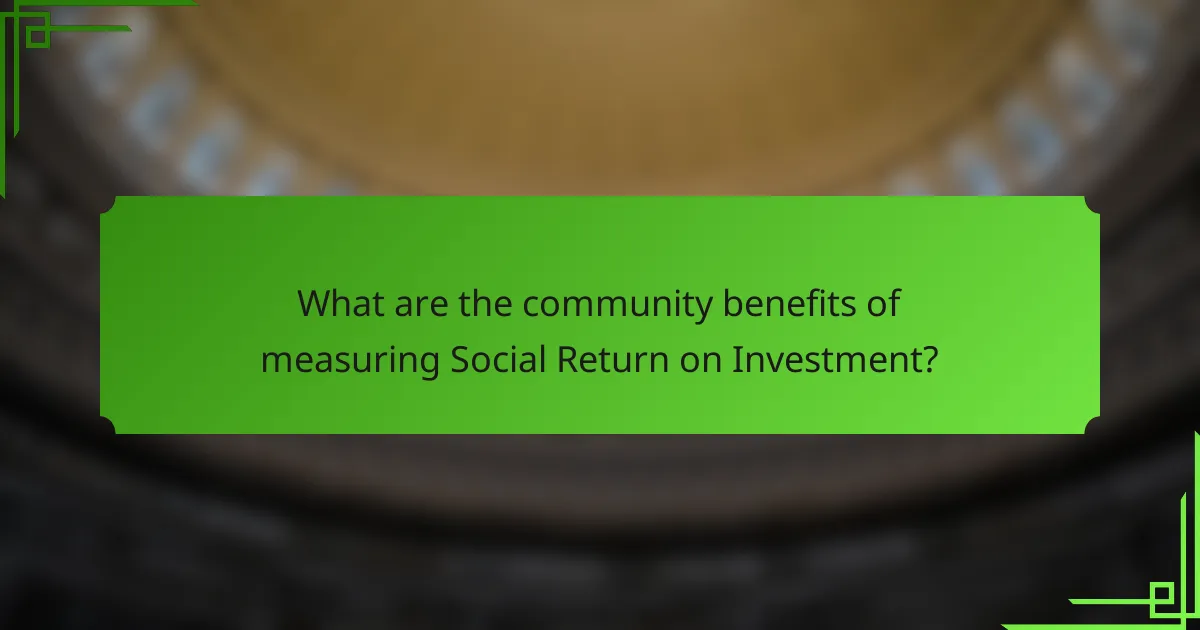Social Return on Investment (SROI) is a valuable framework that quantifies the social, environmental, and economic impacts of local projects. By integrating community benefits with financial metrics, SROI enables stakeholders to assess the true value of their initiatives, facilitating informed decision-making and effective resource allocation for enhanced community welfare.

How does Social Return on Investment apply to local projects?
Social Return on Investment (SROI) measures the social, environmental, and economic value generated by local projects. By quantifying community benefits alongside financial metrics, SROI helps stakeholders understand the broader impact of their initiatives.
Community engagement metrics
Community engagement metrics assess how well local projects involve and benefit the community. Key indicators include participation rates, volunteer hours, and feedback from community members. Tracking these metrics helps organizations gauge the effectiveness of their outreach and adapt strategies accordingly.
For example, a project may aim for a 30% increase in community participation over a year. Regular surveys can provide insights into community sentiment and areas for improvement.
Economic impact assessments
Economic impact assessments evaluate the financial implications of local projects on the surrounding area. These assessments typically consider job creation, local spending, and tax revenue generation. Understanding these factors helps stakeholders justify investments and secure funding.
For instance, a community center project might project to create 50 new jobs and generate $500,000 in local spending annually. Such figures can be compelling when presenting to potential investors or government entities.
Case studies from Los Angeles
Los Angeles has implemented various local projects that exemplify SROI principles. One notable case is the revitalization of public parks, which not only improved green space but also increased community health and reduced crime rates. The project demonstrated a significant return in social value through enhanced community well-being.
Another example is a workforce development program that trained residents in high-demand skills. This initiative resulted in a measurable decrease in unemployment rates in the targeted neighborhoods, showcasing the economic benefits of investing in local talent.
Examples from Chicago
In Chicago, local projects focusing on affordable housing have shown strong SROI outcomes. Initiatives that provide low-income families with stable housing have led to improved educational performance among children and decreased healthcare costs, highlighting the multifaceted benefits of such investments.
Additionally, a community-based arts program in Chicago has successfully engaged residents while fostering local talent. By measuring attendance and participant feedback, the program has demonstrated its positive impact on community cohesion and local culture.

What financial metrics are used to measure Social Return on Investment?
Financial metrics for measuring Social Return on Investment (SROI) include various analytical tools that assess the economic value created by social projects. These metrics help organizations quantify the benefits relative to the costs, enabling informed decision-making about resource allocation.
Cost-benefit analysis
Cost-benefit analysis (CBA) evaluates the total expected costs against the total expected benefits of a project. This metric helps stakeholders determine whether the benefits outweigh the costs, typically expressed in monetary terms. For local projects, consider both direct financial impacts and broader social benefits, such as improved community health or reduced crime rates.
When conducting a CBA, it is essential to identify all relevant costs, including initial investments, operational expenses, and potential risks. Benefits should encompass tangible outcomes, like job creation, and intangible effects, such as enhanced community cohesion.
Net present value calculations
Net present value (NPV) calculations assess the profitability of a project by comparing the present value of cash inflows to cash outflows over time. A positive NPV indicates that the project is expected to generate more value than it costs, making it a viable investment. This metric is particularly useful for local projects with long-term benefits, as it accounts for the time value of money.
To calculate NPV, discount future cash flows to their present value using an appropriate discount rate, which reflects the risk and opportunity cost of capital. Ensure to consider the local economic context, as discount rates can vary significantly based on regional financial conditions.
Return on investment ratios
Return on investment (ROI) ratios measure the efficiency of an investment by comparing the net profit to the initial cost. This straightforward metric helps stakeholders understand the financial return relative to the resources invested. For community projects, a higher ROI indicates a more effective use of funds in generating social benefits.
To calculate ROI, use the formula: (Net Profit / Cost of Investment) x 100. It’s crucial to include both direct financial returns and social impacts in the profit calculation, especially for projects aimed at community development. Regularly reviewing ROI can help identify successful initiatives and areas needing improvement.

What are the community benefits of measuring Social Return on Investment?
Measuring Social Return on Investment (SROI) provides communities with a framework to evaluate the social, environmental, and economic impacts of local projects. By quantifying these benefits, stakeholders can make informed decisions that enhance community welfare and resource allocation.
Improved public services
Measuring SROI helps identify which public services yield the greatest social benefits, allowing for better resource distribution. For instance, programs that focus on education or health can be prioritized based on their positive impacts, leading to enhanced service delivery.
Communities can use SROI metrics to advocate for funding and support from local governments. By demonstrating the tangible benefits of specific initiatives, such as reduced crime rates or improved health outcomes, communities can secure necessary investments.
Enhanced community well-being
Communities that measure SROI often see improvements in overall well-being, as projects are aligned with residents’ needs. Initiatives that address mental health, social cohesion, and access to recreational activities can significantly uplift community morale.
For example, community gardens or local art programs can foster social connections and improve mental health, which are crucial components of well-being. By tracking these benefits, communities can justify ongoing support and funding for such initiatives.
Increased local employment opportunities
Measuring SROI can highlight the economic benefits of local projects, particularly in job creation. Initiatives that focus on skills training or support for local businesses can lead to increased employment rates, benefiting the community economically.
For instance, a local training program that prepares individuals for jobs in renewable energy can not only reduce unemployment but also contribute to a sustainable economy. By quantifying these outcomes, stakeholders can attract further investment and support for similar projects.

What frameworks exist for evaluating Social Return on Investment?
Several frameworks are available for evaluating Social Return on Investment (SROI), each offering unique methodologies and insights. The most common include logic models and theories of change, which help organizations articulate their goals and measure the impact of their projects on communities.
Logic models
Logic models provide a visual representation of how a program or project is expected to work. They outline the relationship between resources, activities, outputs, and outcomes, making it easier to identify the intended social impacts. A well-structured logic model can help stakeholders understand the flow of resources and the expected benefits.
When creating a logic model, consider including key components such as inputs (resources allocated), activities (program actions), outputs (direct results), and outcomes (long-term effects). For example, a community garden project might list seeds and tools as inputs, gardening workshops as activities, harvested produce as outputs, and improved community health as an outcome.
Theory of change
Theory of change is a comprehensive framework that outlines the steps necessary to achieve a desired social outcome. It emphasizes the importance of understanding the context and assumptions behind a project, ensuring that all stakeholders are aligned on the intended impact. This approach encourages critical thinking about how change occurs and the factors that influence it.
To develop a theory of change, start by clearly defining the long-term goals and then work backward to identify the necessary preconditions and interventions. For instance, if the goal is to reduce youth unemployment, the theory might include preconditions such as improved job skills and increased access to job opportunities, along with specific programs to address these needs.

How can organizations implement Social Return on Investment strategies?
Organizations can implement Social Return on Investment (SROI) strategies by systematically measuring and analyzing the social, environmental, and economic value generated by their projects. This involves defining clear objectives, engaging stakeholders, and using metrics to assess the impact of local initiatives.
Steps for integrating metrics
To effectively integrate metrics into SROI strategies, organizations should start by identifying key performance indicators (KPIs) that align with their goals. These KPIs can include community engagement levels, economic benefits, and environmental improvements. Establishing a baseline for these metrics allows for meaningful comparisons over time.
Next, organizations should collect data through surveys, interviews, and financial records to evaluate the outcomes of their projects. Regularly reviewing this data helps in adjusting strategies and improving future initiatives. Utilizing software tools can streamline data collection and analysis, making it easier to visualize results.
Best practices for local engagement
Effective local engagement is crucial for the success of SROI strategies. Organizations should prioritize building relationships with community members and stakeholders through regular communication and collaboration. Hosting workshops and community meetings can foster a sense of ownership and encourage participation.
Additionally, organizations should be transparent about their goals and the potential impacts of their projects. Sharing success stories and challenges can enhance trust and motivate community members to contribute. It’s also beneficial to adapt engagement strategies based on feedback, ensuring that the initiatives remain relevant and beneficial to the local population.
